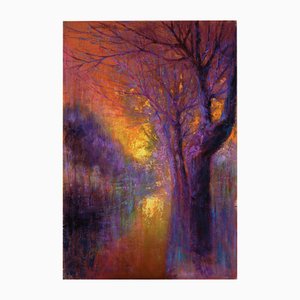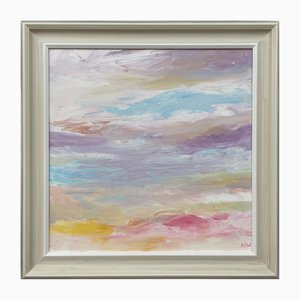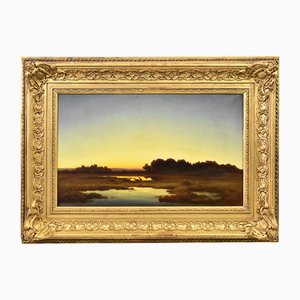Traduzione generata automaticamente
Mostra originale
Mostra traduzione
Style : French school XXth century
Condition : Excellent
Technique : Oil on canvas
Other : Signed lower right and dated 1906.
Height : 45 cm
Width : 55 cm
Dimensions with the frame: 62 cm/ 71 cm
Here is an interesting work by its pointillist character and its year of execution (1906) ... We were not able to locate the place but it is perhaps the Canal du Loing which was also frequented by the friend of the painter Alfred Sisley... No certainty however.
This luminous work, shows all the talent of this artist who was hermetic to the great mediatization, what left him far from the big demonstrations and explains certainly his relative anonymity... He remains an excellent painter who could have joined the Pantheon of the impressionists...
Antony Damien
1858 - 1943
Painter
Self-taught, Antony Damien is a friend of Alfred Sisley and Jean-François Raffaelli whom he considers as his masters. Sensitive to changes in light and weather phenomena, he painted many landscapes of Paris and its surroundings, but also in the provinces.
He exhibited at the Salon des artistes français in 1890 Vieux hêtres and Forêt de Fontainebleau, and at the Salon de la Société nationale des beaux-arts in 1921 Maison à travers les arbres and in 1922 Neige.
Unlike his friend Sisley who ended his life in poverty, Antony Damien was never in need.
Antony Damien married Julie Gano in a first marriage, to which the painter Antoine Guillemet was witness. He married Marie Pironnet, a student of Vincent d'Indy and professor of singing at the Schola Cantorum, in 1919.
He is the half-brother of the playwright Eugène Damien (1846-1902) and the uncle of Gustave Damien, actor and director of theatrical tours.
His mother Louise Alphonsine Hubert married in 1885 Jacques Alexandre Robert Dumesnil, Notary, the son of Alexandre-Pierre-François Robert-Dumenil, also a notary and a print lover and French art historian, known for his book Le peintre-graveur français ou Catalogue raisonné des estampes gravées par les peintres et les dessinateurs de l'École française (1938), which is a sequel to Adam von Bartsch's Peintre-graveur, but concerning French printmakers.
Antony Damien is a researcher, his work is uneven but sincere. His age will not stop his evolution. His palette, as he grew older, took on more muted tones.
In 1939, a congestion will affect his vision of colors. Nevertheless, he started to paint again, sometimes finding, despite the grey echoes of the war, a semblance of good humor. A few weeks before his death, still seeking to renew himself, he sketched a last canvas.
"Antony Damien was an original, a pure independent who feared praise, criticism and merchants, a man of character - and everyone knows that men of character generally have it bad.
This is an unusual destiny for this work which, during the sixty years of its creation," wrote his biographer Jacques Saisset in 1947, "passed silently but without fail from the easel where it was born to the walls of bourgeois homes.
Damien is not included in any museum; only the Fontainbleau town hall has preserved La Celle-sur-Seine, one of the landscapes that was auctioned off in that city on August 8, 1943. Cheerful and Rabelaisian, noisy, athletic, getting up at 5 o'clock every morning to go on the motif, he took pleasure in discouraging his possible amateurs ("My painting pleases you, what do you want it to do to me?"). An attitude that can explain the oblivion into which these works have fallen, all of light and reflections, of fine grays very lightly colored, supported by a drawing that is both firm and blurred, paintings that have the transparency and vibration of pastel: "Nature is blond," he said, "it must be painted with distinguished tones:
A landscape must be enveloped, to make dream".
He attenuated the brightness of the colors by absorbing preparations with the white of Meudon which "make pass the oil on the other side of the canvas".
Initially destined for a dramatic career, he then composed a few station posters and went to paint as a simple amateur, in the company of Sisley and Raffaëli, whom he always considered his masters; he also frequented Le Sidaner, whose influence he temporarily underwent.
Around 1892, he discovered Chateurenard and often returned to work there for over thirty years.
In 1899, he settled in La Celle-sur-Seine and then ten years later in Moret, renting the apartment in Fontainbleau where he would end his life.
In addition to landscapes of the Loiret and Normandy, he left city views, of Avignon for example and of Paris, where one can read different variations on his favorite places, the Bastille, the Boulevard Raspail and the Place Saint-André-des-Arts.
Stile : Scuola francese del XX secolo
Condizioni: Ottime
Tecnica : Olio su tela
Altro : Firmato in basso a destra e datato 1906.
Altezza : 45 cm
Larghezza: 55 cm
Dimensioni con la cornice: 62 cm/ 71 cm
Ecco un'opera interessante per il suo carattere divisionista e per l'anno di esecuzione (1906)... Non siamo riusciti a localizzare il luogo ma forse si tratta del Canal du Loing che fu frequentato anche dall'amico pittore Alfred Sisley... Nessuna certezza comunque.
Quest'opera luminosa, mostra tutto il talento di questo artista che fu ermetico alla grande mediatizzazione, che lo lasciò lontano dalle grandi manifestazioni e spiega certamente il suo relativo anonimato... Resta un eccellente pittore che avrebbe potuto entrare nel Pantheon degli impressionisti...
Antonio Damiano
1858 - 1943
Pittore
Autodidatta, Antony Damien è amico di Alfred Sisley e Jean-François Raffaelli, che considera i suoi maestri. Sensibile ai cambiamenti di luce e ai fenomeni atmosferici, dipinge molti paesaggi di Parigi e dintorni, ma anche della provincia.
Espone al Salon des artistes français nel 1890 Vieux hêtres e Forêt de Fontainebleau, e al Salon de la Société nationale des beaux-arts nel 1921 Maison à travers les arbres e nel 1922 Neige.
A differenza dell'amico Sisley, che finì la sua vita in povertà, Antony Damien non fu mai in difficoltà.
Antony Damien sposò in prime nozze Julie Gano, di cui fu testimone il pittore Antoine Guillemet. Nel 1919 sposò Marie Pironnet, allieva di Vincent d'Indy e docente di canto alla Schola Cantorum.
È fratellastro del drammaturgo Eugène Damien (1846-1902) e zio di Gustave Damien, attore e direttore di tournée teatrali.
Sua madre Louise Alphonsine Hubert sposò nel 1885 Jacques Alexandre Robert Dumesnil, notaio, figlio di Alexandre-Pierre-François Robert-Dumenil, anch'egli notaio, appassionato di stampe e storico dell'arte francese, noto per il suo libro Le peintre-graveur français ou Catalogue raisonné des estampes gravées par les peintres et les dessinateurs de l'École française (1938), che è il seguito del Peintre-graveur di Adam von Bartsch, ma riguarda gli stampatori francesi.
Antony Damien è un ricercatore, il suo lavoro è disomogeneo ma sincero. L'età non fermerà la sua evoluzione. La sua tavolozza, con l'avanzare dell'età, assume toni più tenui.
Nel 1939, una congestione comprometterà la sua visione dei colori. Tuttavia, ricomincia a dipingere, trovando talvolta, nonostante gli echi grigi della guerra, una parvenza di buon umore. Poche settimane prima della morte, ancora alla ricerca di un rinnovamento, abbozza un'ultima tela.
"Antony Damien era un originale, un puro indipendente che temeva le lodi, le critiche e i mercanti, un uomo di carattere - e tutti sanno che gli uomini di carattere in genere se la passano male.
È un destino insolito per quest'opera che, durante i sessant'anni della sua creazione", scriveva il suo biografo Jacques Saisset nel 1947, "è passata silenziosamente, ma senza errori, dal cavalletto dove è nata alle pareti delle case borghesi".
Damien non è presente in nessun museo; solo il municipio di Fontainbleau ha conservato La Celle-sur-Seine, uno dei paesaggi messi all'asta in quella città l'8 agosto 1943. Allegro e rabelaisiano, rumoroso, atletico, che si alzava ogni mattina alle 5 per andare al motivo, si divertiva a scoraggiare i suoi possibili dilettanti ("La mia pittura vi piace, cosa volete che mi faccia?"). Un atteggiamento che può spiegare l'oblio in cui sono cadute queste opere, tutte di luce e di riflessi, di grigi sottili molto leggermente colorati, sostenuti da un disegno insieme fermo e sfumato, quadri che hanno la trasparenza e la vibrazione del pastello: "La natura è bionda", diceva, "bisogna dipingerla con toni distinti":
Un paesaggio deve essere avvolto, per far sognare".
Attenua la luminosità dei colori assorbendo le preparazioni con il bianco di Meudon che "fa passare l'olio dall'altra parte della tela".
Inizialmente destinato alla carriera drammatica, compose poi alcuni manifesti di stazione e si dedicò alla pittura come semplice dilettante, in compagnia di Sisley e Raffaëli, che considerò sempre suoi maestri; frequentò anche Le Sidaner, di cui subì temporaneamente l'influenza.
Intorno al 1892 scopre Chateurenard e vi torna spesso a lavorare per oltre trent'anni.
Nel 1899 si stabilisce a La Celle-sur-Seine e dieci anni dopo a Moret, affittando l'appartamento di Fontainbleau dove concluderà la sua vita.
Oltre ai paesaggi del Loiret e della Normandia, ha lasciato vedute di città, ad esempio di Avignone e di Parigi, dove si possono leggere diverse variazioni sui suoi luoghi preferiti, la Bastiglia, il Boulevard Raspail e la Place Saint-André-des-Arts.




Contattaci
Fai un'offerta
Abbiamo notato che sei nuovo su Pamono!
Accetta i Termini e condizioni e l'Informativa sulla privacy
Contattaci
Fai un'offerta
Ci siamo quasi!
Per seguire la conversazione sulla piattaforma, si prega di completare la registrazione. Per procedere con la tua offerta sulla piattaforma, ti preghiamo di completare la registrazione.Successo
Grazie per la vostra richiesta, qualcuno del nostro team vi contatterà a breve.
Se sei un professionista del design, fai domanda qui per i vantaggi del Programma Commerciale di Pamono